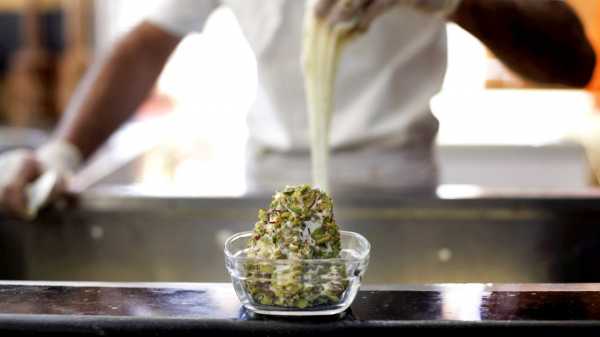
Bakdash, the most celebrated ice-cream parlor in the Middle East, is a
hundred-and-thirty-eight-year-old shop located in the al-Hamidiyah Souk,
an Ottoman-era marketplace in Damascus’s Old City. Men in butcher caps,
white gloves, and coats staff the long, narrow space, serving customers
who over the decades have included King Faisal, of Iraq; Tony Blair;
and Lawrence of Arabia. But the real spectacle is toward the back of the
store, where younger men in tight white T-shirts stand behind chilled
buckets wielding giant wooden pestles. They rhythmically pound what’s
inside: bouza, an ice cream made with mastic, a tree resin that’s the
key component of chewing gum, and sahleb, a flour derived from orchid
roots. Those two ingredients, and the vigorous beating, give bouza its distinctive consistency of cold, stretchy taffy.
Maher Nakhal, who runs a bakery called Le Mirage Pastry, in Anaheim, California, grew
up in Damascus eating at Bakdash once a week, a promised treat at the
end of days spent shopping with his family. The fifty-five-year-old has
been a baker since his late teens, and came to the United States in 1992
at the invitation of his sister. In 2003, he opened his bakery, at the
north end of Anaheim’s Little Arabia district. More than twenty-five
thousand people, primarily of Syrian, Lebanese, Palestinian, and
Egyptian descent, live around a four-mile stretch of the district’s main
thoroughfare, Brookhurst Street, making it one of the largest Middle
Eastern enclaves in the United States. Hookah lounges, mosques, kebab
houses, and Arab grocery stores occupy shopping plazas that also host
tattoo parlors, smoke shops, and car alarm stores. “There were a lot of
Arabs when I opened, and there’s even more now,” Nakhal, who has blue
eyes, a sturdy mustache, and the affability of a favorite uncle, said on
a recent weekday morning. “This can be the next Dearborn, Michigan.”
Around five years ago, just before the Syrian civil war escalated,
Nakhal travelled to Damascus to visit his family. The neighborhood around
Bakdash, which contains national treasures like the Mausoleum of Saladin
and the Umayyad Mosque, has seen little violence during the country’s
conflict (although its owners opened a satellite shop in Amman some
years ago to serve the half-million Syrians who have fled to neighboring
Jordan). Soon after Nakhal returned to the U.S., an influx of refugees
reached Anaheim, and Nakhal had the idea to serve bouza in his shop. He
ordered a machine over the phone from the Syrian manufacturer who makes
Bakdash’s models; with shipping costs and tariffs, it cost him around
twelve thousand dollars. “I wanted to bring my childhood back to the
United States,” he said.
The contraption looks like a taco cart—wheeled, rectangular, waist-high—with a compressor and a freezer instead of a gas tank, and a
built-in steel tub that chills the ice cream to forty degrees below
zero. Nakhal commissioned a handcrafted brass bas-relief to decorate its
sides; it features a man who stands behind a similar machine as he holds
a pestle almost as large as he is. Above the man, in Arabic, are the
words “Arabic Ice Cream.” Other than these custom details, there’s nothing
particularly unique about Bakdash’s bouza machine; Alibaba lists similar
models (complete with a fake Bakdash logo and the wrong year of its
founding) for under a thousand dollars. But Nakhal insists that he
needed an authentic model in order to make bouza right. When I visited
his bakery on a recent morning, as he and his brother Humam prepped a
new batch, Nakhal told me, “If I want to do something, I do it the proper
way—no monkey business.”
The only problem is that the machine never worked; electricians couldn’t
convert it to American voltage. It now sits next to Le Mirage’s
entrance, holding trays of knafeh, a traditional Palestinian cheese
pastry. “Would cost too much to fix it,” Nakhal said with a shrug.
Instead, last fall, he paid six thousand dollars to purchase and import
a smaller machine—this time with a built-in power converter—and
installed it successfully in Le Mirage’s kitchen. I asked him if U.S.
customs, lately looking for any excuse to question immigrants, had given
him any trouble with such an unlikely import. “No problems at all,” he
said, as if that were a silly question. “It’s an ice-cream machine.”
To make the bouza, Humam first took a canteen of batter (known as sahlab
in its liquid state) and ladled it continuously along the sides of the
frosty tub for about fifteen minutes, until the walls were completely
coated. Once it had congealed, he scraped the sahlab into a slab the
size of a telephone book. “Now comes the work,” he said with a smile, as
he grabbed a yard-long pestle made from walnut wood. Humam is tall and
slender, but with arms like a welterweight. He smashed the bouza for
about three minutes, with the force of someone trying to crush rocks.
Humam flipped the bouza slab and Maher sprinkled Turkish pistachios
(“best in the world”) into the tub as his brother began to pound again.
“I’ve eaten it in the United States from regular ice-cream machines,”
Maher said. “It’s not good. It tastes flat, and it’s no longer doughy.”
After about ten minutes, Maher rolled up the finished bouza. It looked
like a cheese log with the girth of a baseball bat. He sliced off chunks
into two ice-cream glasses, splashed them with rosewater, and handed the
glasses to me and my friend Rida Hamida. Hamida, a staffer for the
California assemblywoman Cristina Garcia, is the daughter of Palestinian
immigrants. After Trump’s election, she teamed up with a
Mexican-American friend to promote Latino-Muslim unity by organizing
culinary tours of Little Arabia and stationing halal taco trucks outside
of mosques.
We tasted the bouza, which was milky and chewy, like a chilled melted
marshmallow. The rosewater added sweetness; the pistachios, crunch and a
slight toastiness. I noticed a familiar aftertaste, a bit like licorice,
that I couldn’t quite place. “You’re thinking of horchata,” Hamida told
me, referring to the rice-water drink that’s popular among Latin
Americans. “It’s the sahleb—it tastes like it,” she said. “That’s why
Arabs love horchata!”
Nakhal promoted his bouza with a Facebook post in December. Business so
far has been steady. A group of Syrian women visit regularly, twenty of
them at a time. Nakhal says that serving ice cream in the United
States to countrymen who have escaped Syria and might
never return is bittersweet. “They come to taste a memory,” he said.
He’d like to eventually sell his bouza for weddings—at Syrian
celebrations ice cream is often eaten in lieu of cake—and buy another
machine that he can transport around town. “Like Cold Stone Creamery,”
he said with a laugh, as Humam wiped down the tub. The brothers are also
thinking about making bouza in flavors like pineapple and mango, to
appeal to Anaheim’s large Latino population. “But the Arab kids, they don’t like the sahleb flavor,” Nakhal
said. “It’s an acquired taste.”
Sourse: newyorker.com






